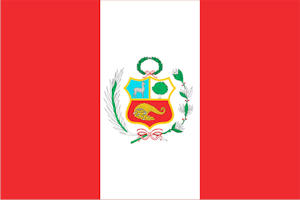Peru Flag Facts
-
Interesting Facts for Kids 1: Peru Flag
The first National Flag of Peru was created by General Don Jose de San Martin in 1820. Over the years, different versions have been woven. The flag of Peru was introduced in 1824 by the government. -
Interesting Facts for Kids 2: Paraguay Flag Day 7th June
Flag Day is celebrated on June 7 in Peru as this day marks the anniversary of the Battle of Arica. A battle also known as Assault and Capture of Cape Arica. The Battle of Arica was a battle in the War on the Pacific, and it occurred on June 7, 1880 between Peru and Chile. -
Interesting Facts for Kids 3: Peru Flag
The National Flag of Peru is symbolic to this South American country and can be described as having a vertical triband design featuring three vertical stripes that run the colors of red, white, red from side to side. The outer bands having the color red and the inner, central band being white. -
Interesting Facts for Kids 4: Peru Flag
The design of the National Flag of Peru uses the color red as this was the color of the war of the Incas and it is representative of the bloodshed that occurred during the fight for independence. Red also symbolizes the sacrifices of those who fought and defended Peru. The color white, which lies central to the flag’s triband design, portrays purity of feelings, freedom, social justice and peace. -
Interesting Facts for Kids 5: The Coat of Arms of Peru
The National Flag of Peru features the coat of arms, known as Escudo de Armas in Spanish. The coat of arms is an important symbol of this country’s history, geography, flora and fauna. The emblem is positioned central to the Peruvian flag and its design comprises of a cinchona tree, a cornucopia and a vicuña. -
Interesting Facts for Kids 6: Peruvian Coat of Arms Meaning
The cinchona tree stands against a white background. It is important because this type of tree is native to this part of South America, and therefore, represents the country’s flora. The coat of arms of Peru also features a cornucopia of gold with coins spilling from it. A cornucopia of gold is also known as the horn of plenty. It can be seen on the coat of arms of Peru positioned against a red background. The cornucopia is symbolic of the country’s mineral resources. A South American animal known as a vicuña, is also depicted on the coat of arms. It stands in front of a blue background and looks a little like a llama; the animal to which the vicuña is related.
